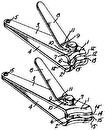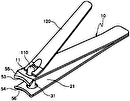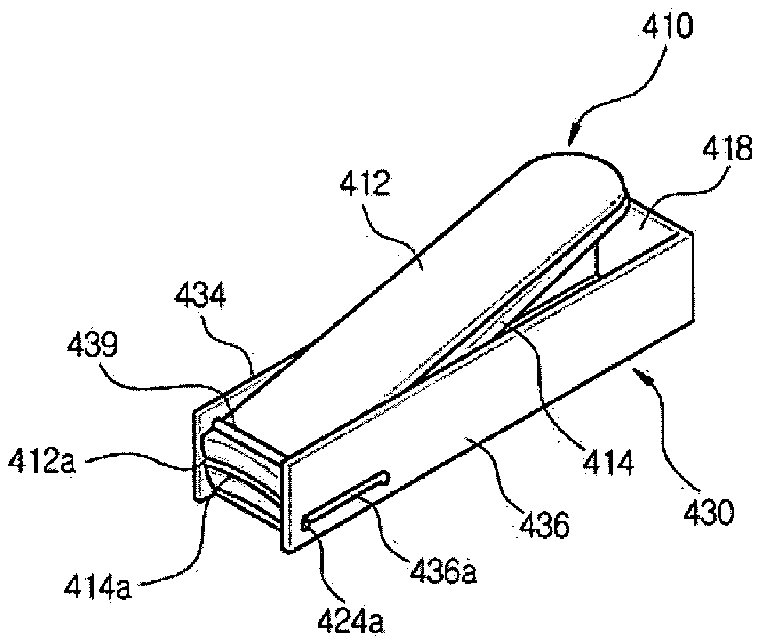
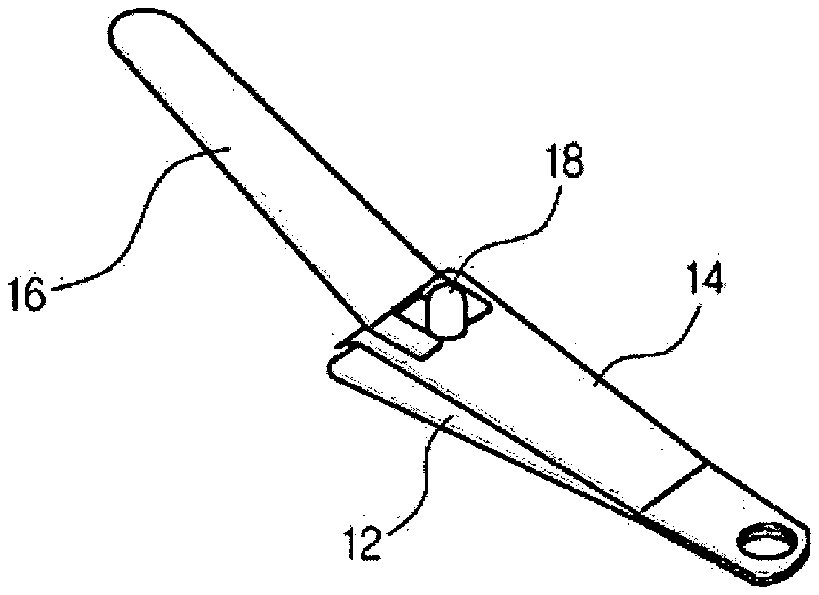
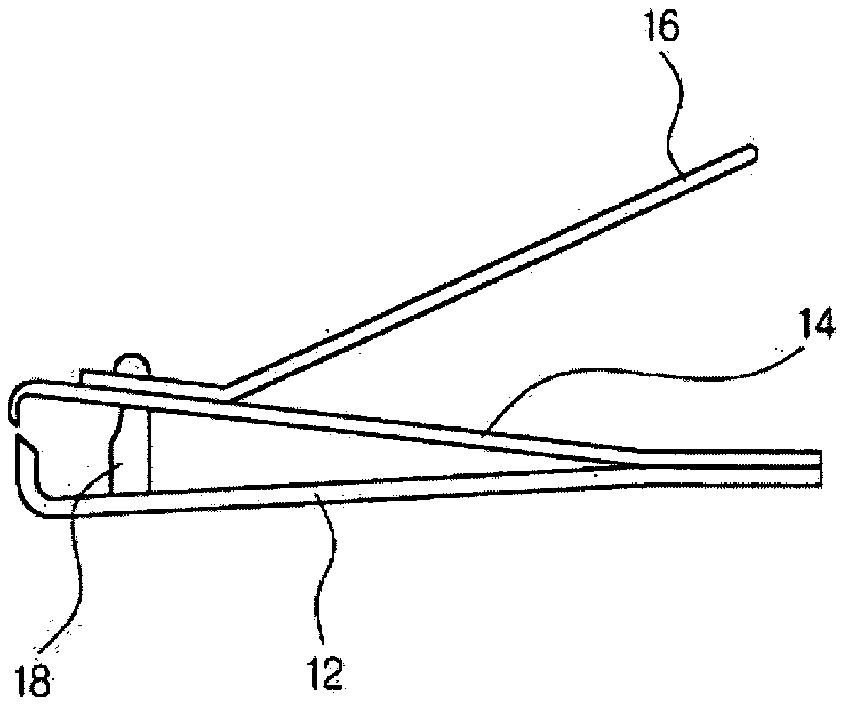
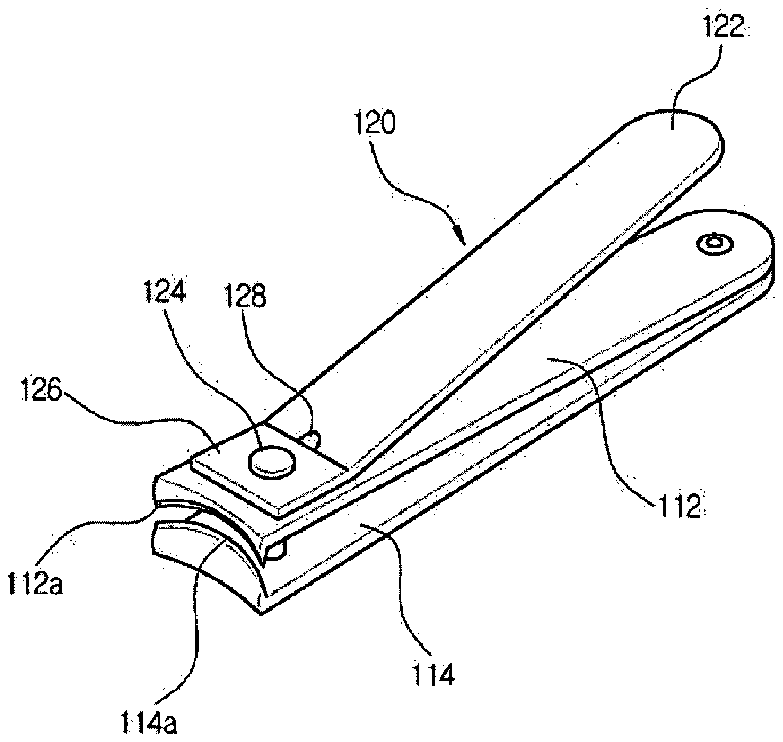
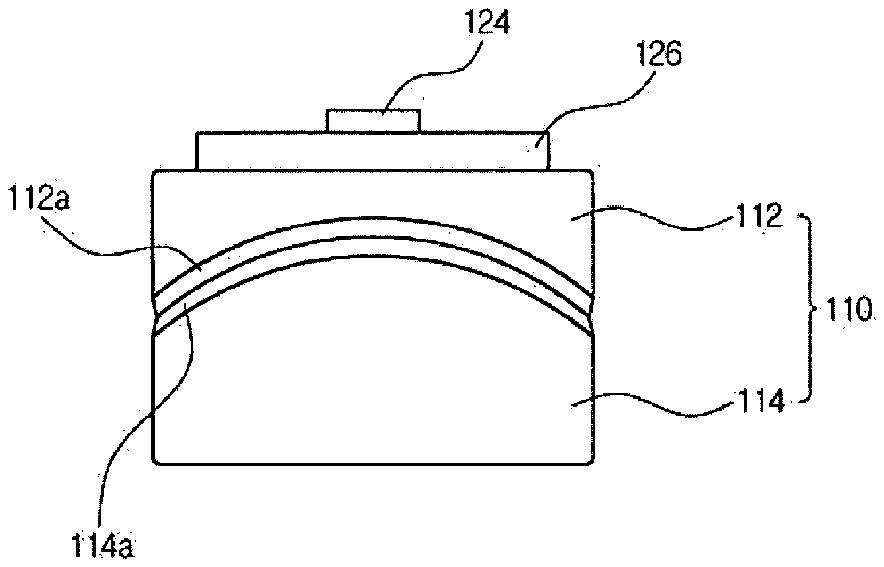
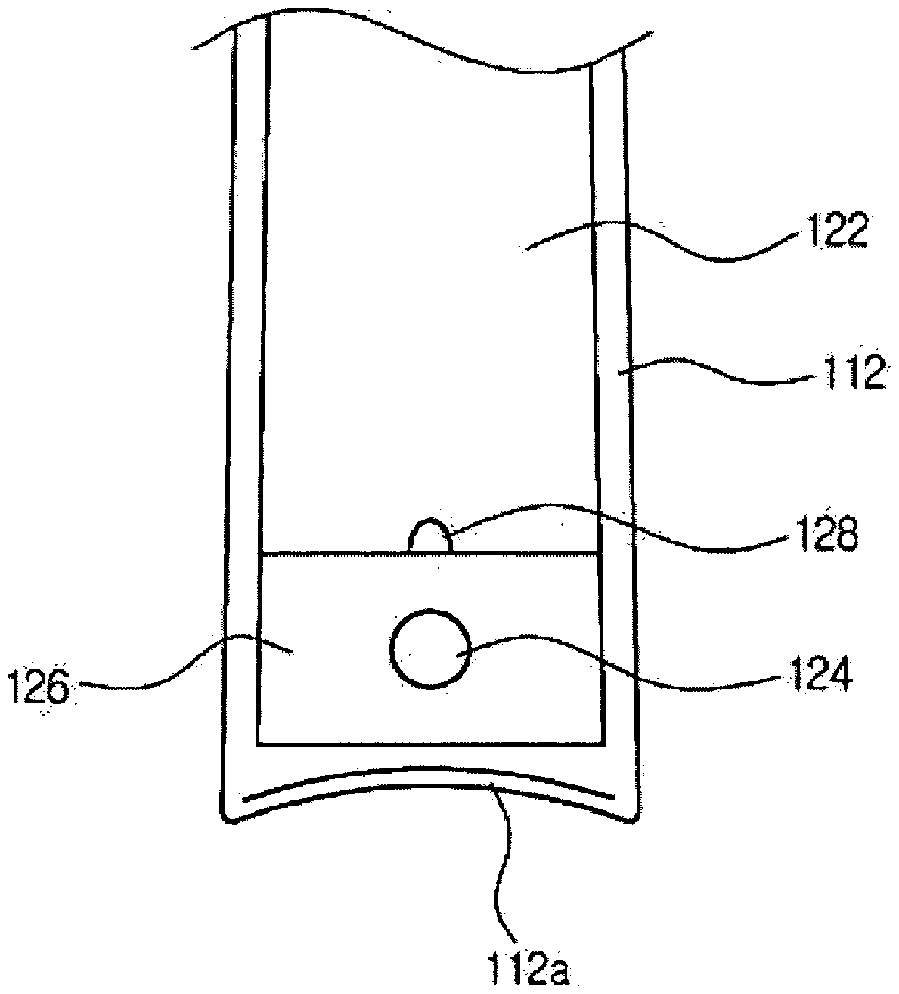
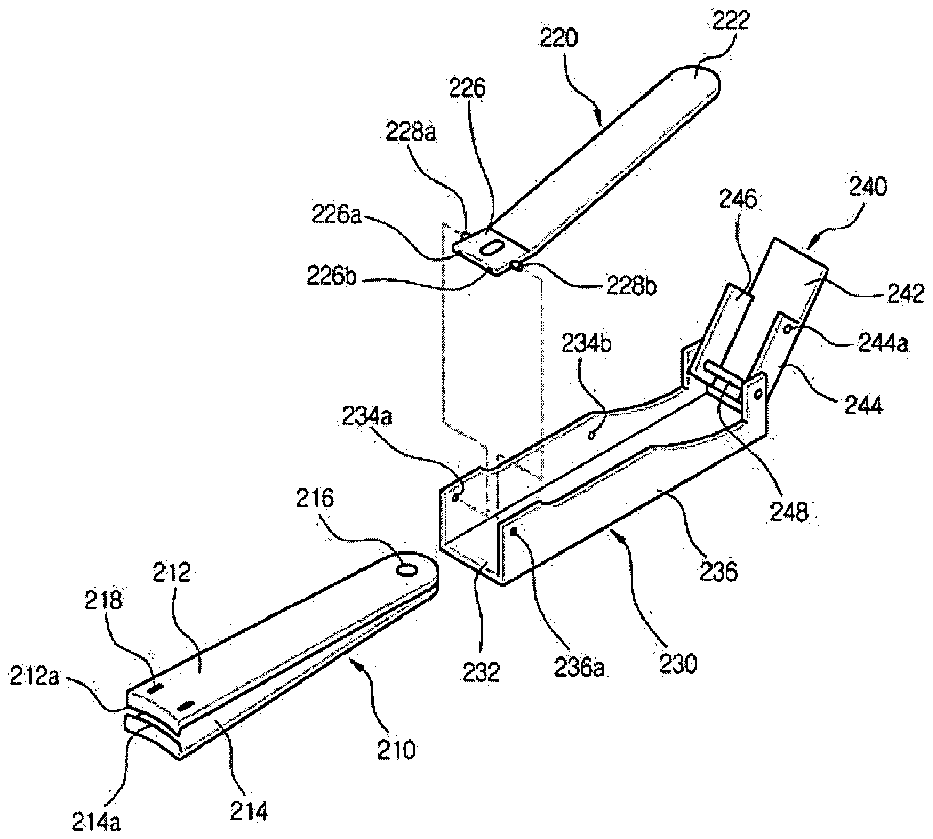
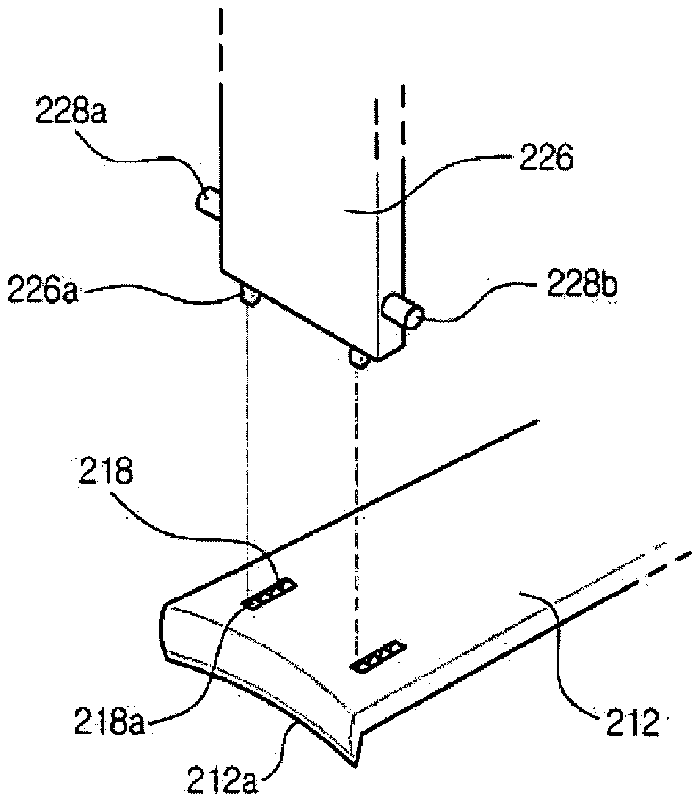
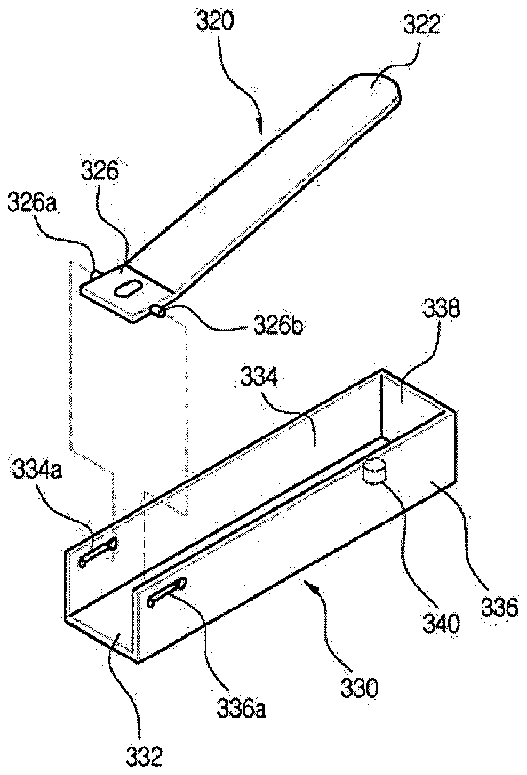
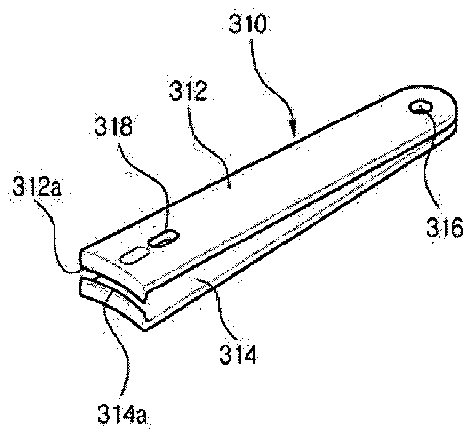
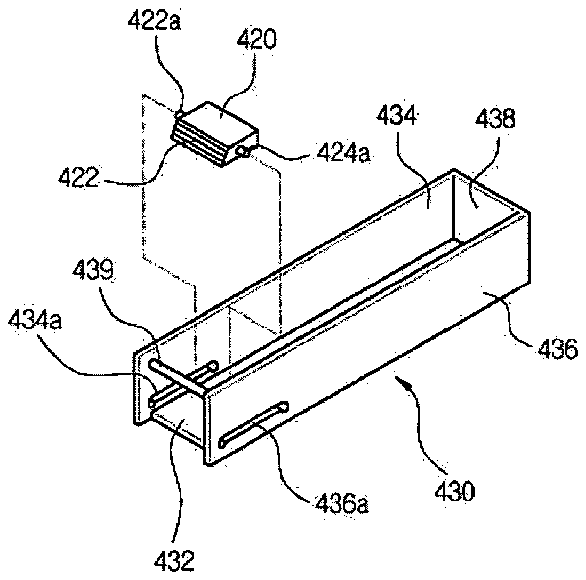
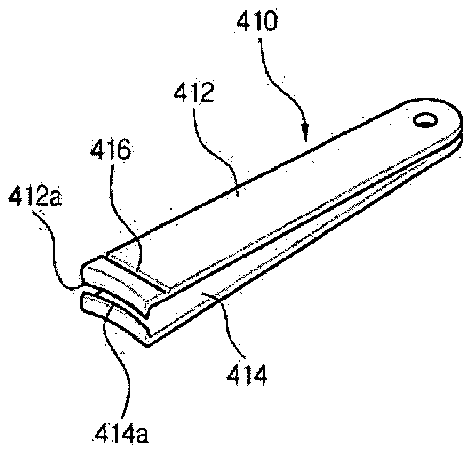
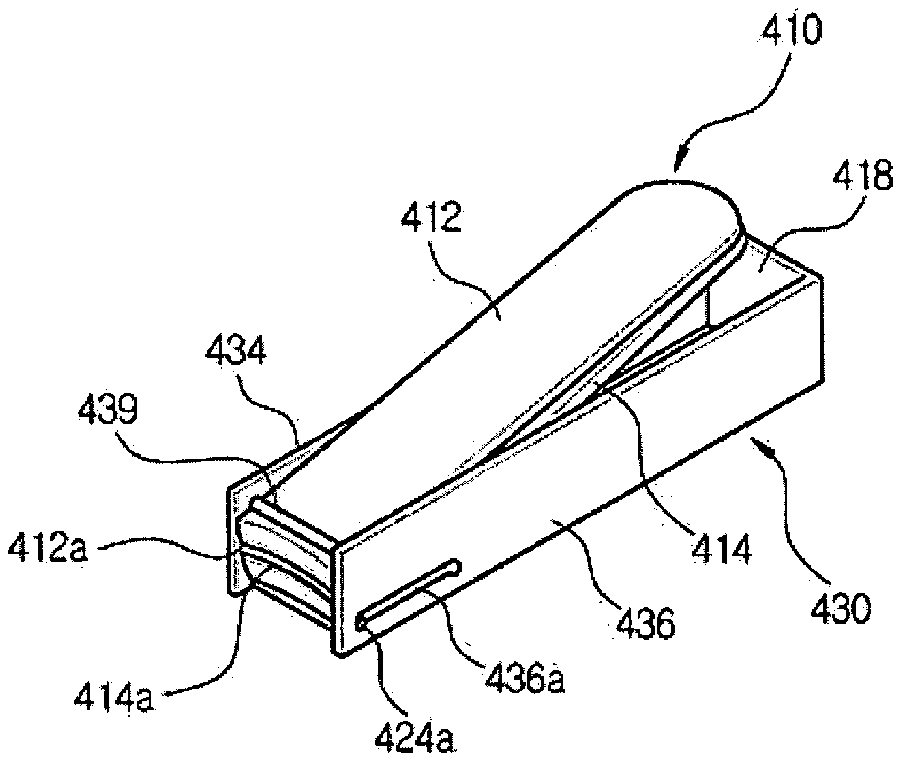
- 10nail clipper
- 14member
- 16lever member
- 18post
- 100nail clipper
- 110blade body
- 112upper blade
- 114lower blade
- 120lever assembly
- 122lever
- 124post
- 126bent portion
- 128abutment projection
- 200nail clipper
- 210blade body
- 212upper blade
- 213lower blade
- 214cutting edge
- 216thru-hole
- 218rectangular grooves
- 220lever
- 222body
- 226bent portion
- 228protrusions
- 230casing
- 232bottom wall
- 234sidewalls
- 240cover
- 242ceiling wall
- 244sidewalls
- 248connecting bar
- 300nail clipper
- 310blade body
- 312upper blade
- 313lower blade
- 316thru-hole
- 318rectangular groove
- 320lever
- 322body
- 326bent portion
- 330casing
- 332bottom wall
- 334rectangular thru-holes
- 338rear wall
- 340stem
- 400nail clipper
- 410blade body
- 412upper blade
- 414lower blade
- 416elongated groove
- 420lever member
- 422protrusions
- 430casing
- 432bottom wall portion
- 434side wall portions
- 436side wall portions
- 438rear wall portion
- 439horizontal member
Abstract
Disclosed is a nail clipper provided with cutting edges having a curvature corresponding to a section and a curve of a nail, in which a blade body can be replaced with one having suitable cutting edges according to a shape and a size of a nail. In a nail clipper according to one embodiment of the present invention, cutting edges formed at one ends of upper and lower blades of a blade body are curved with a first curvature to the one end of the blade body while being bent with a second curvature with respect to the blade body. In a nail clipper according to another embodiment of the present invention, a blade body is removably received in a casing and a lever for applying force to the blade body is coupled to the casing. Since the blade body can be removably disposed in the casing, thus, it is possible that one having cutting edges corresponding to a size of the nail can be coupled to the casing, instead of the blade body.
Description
BACKGROUND OF THE INVENTION
[0001] 1. Field of the Invention
[0002] The present invention relates to a nail clipper, and more particularly to a nail clipper provided with cutting edges having a curvature corresponding to a section and a curve of a nail, in which a blade body can be replaced with one having suitable cutting edges according to a shape and a size of a nail.
[0003] 2. Description of the Related Art
[0004] Generally, a nail clipper is used for cutting finger and toe nails. Typical nail clipper is comprised of upper and lower blade each having cutting edge and a lever for applying force to the upper blade with respect to the lower blade so that the cutting edges of the upper and lower blades bring into contact with each other.
[0005] The cutting edges of the upper and lower blades of the nail clipper typically have a shape with curvature corresponding to a curve of a nail end. When user cuts nails with the nail clipper in order to care the nails, therefore, the nails are cut with a desired curvature by means of the cutting edges of the upper and lower blade of the nail clipper.
[0006] U.S. Pat. No. 6,438,845, which is issued to Kook E. Jung on Aug. 17, 2002, discloses a nail clipper device with a scissor-like cutting configuration.
[0007] [0007]FIG. 1 is a perspective view of the nail clipper according to Jung's Patent, and FIG. 2 is a side view of the nail clipper according to the Jung's Patent shown in FIG. 1.
[0008] As shown in FIGS. 1 and 2, the nail clipper 10 comprises elongated upper and lower operating members 12 and 14 each having first ends joined together, and second ends terminating in spaced complimentary shaped cutting edges, a post 18 secured to the lower operating member 12 and movably extending through an aperture in the upper member 14 adjacent the cutting edges, and a lever member 16 having first and second ends with the end beginning pivotally secured to the post 18 .
[0009] The lever member 16 is superimposed over the upper operating member 14 in a non-operable position. Also, the lever member 16 has a bent portion adjacent the post 18 so that the lever member is first pivoted about the axis of the post 18 and pivoted in over the post to an operating position.
[0010] The bent portion of the lever member 16 will bear against the upper operating member to move the cutting edge. Each cutting edge of the nail clipper 10 has slanted cutting surfaces and complementary cutting surfaces that are moved adjacent to each other.
[0011] The nail clipper 10 according to the Jung's Patent constructed as described above has an advantage in that it can easily cut thick and inflexible finger and toe nails.
[0012] In the nail clipper, however, since the cutting surfaces of the cutting edges are in flat, there is a disadvantage in that it is difficult to cut the nail along a curve of the nail when performing to cut the nail. In the casing of a large nail, since the nail is partially cut along the curve of the nail, especially, there is a problem in that it is very difficult to smoothly cut the nail at a time.
SUMMARY OF THE INVENTION
[0013] The present invention has developed to solve the foregoing problems. It is a first object of the present invention to provide a nail clipper having cutting edges with curvatures corresponding to a sectional shape and curve of the nail.
[0014] It is a second object of the present invention to provide a nail clipper in which a blade body can be replace with one having suitable cutting edges corresponding to size and shape of nails.
[0015] In order to achieve the first object of the present invention, according to a first embodiment of the present invention, there is provided a nail clipper comprising: a blade body including an upper blade having a cutting edge at an end thereof and a lower blade having a cutting edge at an end thereof, of which the other end is joined to the other end of the upper blade, the cutting edges, which are provided at one ends of the upper blade and the lower blade of the blade body, being bent toward the blade body with a first certain curvature while being curved with reference to the blade body with a second certain curvature; and a lever assembly which is associated with the blade body at a position adjacent to one end of the blade body, for applying force to the one end of the blade body so that the cutting edge of the upper blade is engaged with that of the lower blade.
[0016] The first curvature of the cutting edges which are respectively provided at the one end of the upper and lower blades corresponds to that of a nail end.
[0017] The second curvature of the cutting edges which are respectively provided at the one end of the upper and lower blades corresponds to a sectional curvature of a nail end.
[0018] In order to achieve the first object of the present invention, according to a first embodiment of the present invention, there is provided a nail clipper comprising: a blade body including an upper blade having a cutting edge at one end thereof and a lower blade having a cutting edge at one end thereof, of which the other end is joined to the other end of the upper blade; a casing for removably receiving the blade body; and a lever which is combined with the casing adjacent to the one end of the blade body received in the casing, for applying force to the one end of the blade body so that the cutting edges of the upper and lower blades of the blade body are engaged with each other.
[0019] The blade body has an aperture at the other end thereof.
[0020] The lever includes a body, a bent portion which is bent at a desired angle with regard to the body, and a pair of protrusions respectively extending at a desired length from both sides of the bent portion.
[0021] The casing includes a bottom wall and a pair of sidewalls extending upwardly from both sides of the bottom wall, the sidewalls respectively having thru-holes adjacent to the one end thereof, the thru-holes having a desired diameter, which are opposite to each other.
[0022] The casing has a cover at the other end thereof in order to protect the blade body and the lever, the cover being pivotally installed to the casing with respect to the casing.
[0023] The sidewalls of the casing respectively have a recess in order to receive the protrusions extending from the sidewalls of the cover so as to fix the cover to the casing.
[0024] The lever is combined with the casing in such a manner that the protrusions respectively extending from the sidewalls of the bent portion are inserted into the thru-holes respectively formed at the one end of the casing.
[0025] A pair of protrusions extends at a desired distance from each other from a front end of the bent portion of the lever, in order to remove the blade body from the casing.
[0026] The upper blade of the blade body has a pair of rectangular grooves on an upper surface thereof in order to receive the protrusions provided at a front end of the bent portion of the lever.
[0027] The rectangular grooves which are formed on the upper surface of the upper blade of the blade body are divided by a plurality of partitions having a slanted surface declined toward the cutting edge.
[0028] In the nail clipper according to the first embodiment of the present invention constructed as described above, since the upper and lower blade have the cutting edges with the first and second curvatures corresponding to those of the nail end, there is an advantage in that the nails can be smoothly cut by means of the nails clipper with minimum cutting operation.
[0029] In the nail clipper according to the second embodiment of the present invention constructed as described above, further, Blade bodies respectively provided with a different cutting edge from each other can be removably joined to the casing and the cutting edges have several shape and size. Thus, there is an advantage in that the suitable blade body can be selected and used for cutting the nails according to the shape and size of the nails.
BRIEF DESCRIPTION OF THE DRAWINGS
[0030] The above objects and advantages of the present invention will become more apparent by describing in detail the preferred embodiments thereof with reference to the attached drawings, in which:
[0031] [0031]FIG. 1 is a perspective view of a nail clipper according to the conventional art;
[0032] [0032]FIG. 2 is a side view of the nail clipper according to the conventional art shown in FIG. 1;
[0033] [0033]FIG. 3 is a perspective view of a nail clipper according to a first embodiment of the present invention;
[0034] [0034]FIG. 4 is a front view of the nail clipper according to the first embodiment of the present invention shown in FIG. 3;
[0035] [0035]FIG. 5 is a plan view of the nail clipper according to the first embodiment of the present invention shown in FIG. 3;
[0036] [0036]FIG. 6 is an exploded perspective view of a nail clipper according to a second embodiment of the present invention;
[0037] [0037]FIG. 7 is a partially enlarged perspective view of the nail clipper according to the second embodiment of the present invention shown in FIG. 6, in which a lever removes a blade body from a casing;
[0038] [0038]FIG. 8 is an exploded perspective view of a nail clipper according to a third embodiment of the present invention;
[0039] [0039]FIG. 9 is an exploded perspective view of a nail clipper according to a fourth embodiment of the present invention; and
[0040] [0040]FIG. 10 is a perspective view of the nail clipper according to the fourth embodiment of the present invention shown in FIG. 9, in which a blade body is joined to a casing that functions as a lever.
DETAILED DESCRIPTION OF THE INVENTION
[0041] Hereinafter, a nail clipper according to the first embodiment of the present invention will be described in more detail with reference to the accompanying drawings.
[0042] [0042]FIG. 3 is a perspective view of the nail clipper 100 according to the first embodiment of the present invention, FIG. 4 is a front view of the nail clipper 100 according to the first embodiment of the present invention shown in FIG. 3, and FIG. 5 is a plan view of the nail clipper 100 according to the first embodiment of the present invention shown in FIG. 3.
[0043] As shown in FIGS. 3 to 5 , the nail clipper 100 according to the first embodiment of the present invention comprises a blade body 110 including an upper blade 112 having a cutting edge 112 a at an end thereof and a lower blade 114 having a cutting edge 114 a at an end thereof, of which the other end is joined to the other end of the upper blade 112 , the cutting edges 112 a and 114 a, which are provided at one ends of the upper blade 112 and the lower blade 114 of the blade body 110 , being bent toward the blade body 110 with a first certain curvature while being curved with reference to the blade body 110 with a second certain curvature; and a lever assembly 120 which is associated with the blade body 110 at a position adjacent to one end of the blade body 110 , for applying force to the one end of the blade body 110 so that the cutting edge 112 a of the upper blade 112 is engaged with that of the lower blade 114 .
[0044] The upper and lower blades 112 and 114 of the blade body 110 are made from a steel plate having desired strength and elasticity by cutting the steel plate in a desired size. The upper and lower blades 112 and 114 respectively have the cutting edges 112 a and 114 a at one end thereof.
[0045] The cutting edges 112 a and 114 a are curved with a first curvature toward the other end of the blade body in a plan view so as to correspond to the curve of the nail, while being curved with a second curvature with respect to a surface of the blade body 110 in a front view so as to meet a sectional end of the nail, as shown in FIGS. 4 and 5.
[0046] The other ends of the upper and lower blades 112 and 114 of the blade body 110 are joined to each other in a manner of welding and the like, so that the upper blade 112 is integrated with the lower blade 114 . In addition, however, the upper blade 112 can be combined with the lower blade at the other end thereof by using a rivet.
[0047] Meanwhile, the upper and lower blades 112 and 114 respectively have a thru-hole at a portion near one end thereof, through which a post 124 of the lever assembly 120 , as described hereinafter, extends.
[0048] The lever assembly 120 includes the post 126 extending through the blade body 110 and a lever 122 pivotally coupled to an upper portion of the post 126 .
[0049] The post 124 extends through the thru-hole from a surface of the lower blade 114 before extending through the upper blade 112 .
[0050] The lever 122 has a bent portion at one end thereof, which has a through-hole through which the post 124 extends to combine the lever 122 to the upper blade 112 so that the lever 122 pivots over the upper blade 112 . Further, an abutment projection is projected at a position near the bent portion 126 of the lever 122 so as to come in contact with the upper blade 112 to enhance a lever operation.
[0051] Hereinafter, an operation and effect of the nail clipper 100 according to the first embodiment of the present invention will be described in detail.
[0052] With the nail clipper 100 according to the first embodiment of the present invention constructed as described above, when a user grips the other end of the lever 122 and the other end of the blade body 110 so as to apply force to the lever 122 and the blade body 110 , the bent portion 126 of the lever 122 pivots upwardly about the abutment projection 128 adjacent to the bent portion 126 of the lever 122 .
[0053] Thus, the upper blade 112 against which the lever 122 bears is pressed in a direction opposite to the bent portion 126 of the lever 122 by means of the lever 122 . As a result, the cutting edges 112 a and 114 a of the upper and lower blades 112 and 114 bring into contact with each other to cut the nail.
[0054] Since the cutting edges 112 a and 114 a of the upper and lower blades 112 and 114 have the first curvature corresponding to the curve of the nail end and the second curvature corresponding to the curve of the sectional end of the nail, the nail clipper according to the first embodiment of the present invention can cut the nail smoothly at a time when cutting the nail.
[0055] Hereinafter, a nail clipper 200 according to the second embodiment of the present invention will be described in detail with reference to the accompanying drawings.
[0056] [0056]FIG. 6 is an exploded perspective view of the nail clipper 200 according to the second embodiment of the present invention, and FIG. 7 is a partially enlarged perspective view of the nail clipper 200 according to the second embodiment of the present invention shown in FIG. 6, in which a lever 222 removes a blade body 210 from a casing 230 .
[0057] As shown in FIGS. 6 and 7, the nail clipper 200 according to the second embodiment of the present invention comprises a blade body 210 including an upper blade 212 having a cutting edge 212 a at one end thereof and a lower blade 214 having a cutting edge 214 a at one end thereof, of which the other end is joined to the other end of the upper blade 212 ; a casing 230 for releasably receiving the blade body 210 ; and a lever 220 which is combined with the casing 230 adjacent to the one end of the blade body 210 received in the casing 230 , for applying force to the one end of the blade body 210 so that the cutting edges 212 a and 214 a of the upper and lower blades 212 and 214 of the blade body 210 are engaged with each other.
[0058] The blade body 210 is comprised of the upper blade 212 and the lower blade 213 . The cutting edges 212 a and 214 a are respectively formed at one end of the upper and lower blades 212 and 214 . The upper and lower blades 212 and 214 are joined to each other at the other end thereof by welding and the like.
[0059] The cutting edges 212 a and 214 a of the upper and lower blades 212 and 214 have a curvature corresponding to a curve of the nail end. However, it is understood that the cutting edges 212 a and 214 a of the upper and lower blades 212 and 214 have a first curvature corresponding to a curve of the nail end and a second curvature corresponding to a curve of a sectional end of the nail.
[0060] The blade body 210 has a thru-hole 216 at the other end of thereof.
[0061] The upper blade 212 has a pair of rectangular grooves 218 on an upper surface adjacent to the one end thereof. The rectangular grooves 218 are divided by a plurality of partitions 218 a. Each partition 218 a has a slanted surface which is declined toward the cutting edge 212 a.
[0062] The rectangular groove 218 divided by the partitions 218 a receives a projection 226 a formed at a front end of a bent portion 226 of a lever 220 as described below when the blade body 210 is removed from the casing 230 as described below.
[0063] The casing 230 includes a bottom wall 232 and a pair of sidewalls 234 and 236 extending from sides of the bottom wall 232 . The sidewalls 234 and 236 respectively have thru-holes 234 a and 236 a with a desired diameter at a portion adjacent to the one end thereof, as shown in FIG. 5.
[0064] The casing 230 has through-holes formed at the other end thereof in which a cover 240 for covering and protecting the blade body 210 and the lever 220 is pivotally mounted. Further, the casing 230 has recesses 234 b at an intermediate portion of sidewalls 234 and 236 thereof to receive a protrusion 244 a for fixing the cover 240 to the casing 230 .
[0065] The cover 240 includes a ceiling wall 242 , sidewalls 244 and 246 extending downwardly from sides of the ceiling wall 242 and a connecting bar 248 extending through the sidewalls 244 and 246 in order to rotatably mount the cover 240 to the casing 230 .
[0066] The protrusions 244 a and 246 a for fixing the cover 240 to the casing 230 are formed at the one end on the sidewalls 244 and 246 of the cover 240 , and the through-holes are formed at the other end of the sidewalls 244 and 246 of the cover 240 , through which the connecting bar 248 extends.
[0067] The lever 220 includes a body 222 , the bent portion 226 to be bent at a desired angle with respect to the body 222 and a pair of protrusions 228 a and 228 b extending at a distance from sides of the bent portion 226 .
[0068] Further, the lever 220 has an abutment projection (not shown) on the bent portion 226 thereof in order to support the lever 220 against the upper blade 212 , when the body 222 of the lever 220 pivots about the protrusions 228 a and 228 b of the bent portion 226 to the blade body 210 .
[0069] In addition, the bent portion 226 of the lever 220 has a pair of projections 226 a and 226 b extending at a desired distance from the front end thereof in order to remove the blade body 210 from the casing 230 . The projections 226 a and 226 b have a length equal to a depth of the rectangular groove 218 formed on an upper surface of the upper blade 212 , which are spaced from each other at the distance between the rectangular grooves 218 .
[0070] The lever 220 is joined to the casing 230 in a manner of inserting the protrusions 228 a and 228 b formed at sides of the bent portion 226 into the through-holes 234 a and 236 a at the one end of the casing 230 .
[0071] Hereinafter, the operation and effect of the nail clipper 200 according to the second embodiment of the present invention will be described in detail.
[0072] With the nail clipper 200 according to the second embodiment of the present invention, as shown in FIGS. 6 and 7, the protrusions 228 a and 228 b formed at sides of the lever 220 firstly are inserted into the thru-holes 234 a and 236 a on the sidewalls 234 and 236 of the casing 230 , so that the lever 220 is pivotally installed to the casing 230 .
[0073] After the thru-holes formed at the other end of the cover 240 are arranged to be coaxial with the through-holes formed at the other end of the casing 230 , the connecting bar 248 is inserted into the thru-holes of the cover 240 and the casing 230 so that the cover 240 is pivotally installed to the casing 230 .
[0074] Finally, the other end of the blade body 210 is inserted between the bottom wall 242 of the casing 230 and the bent portion 226 of the lever 220 in order for the blade body 210 to be introduced in the casing 230 .
[0075] The blade body 210 inserted in the casing 230 is tightly disposed between the lever 220 and the bottom wall 232 of the casing 230 by its elasticity.
[0076] In the nail clipper 200 according to the second embodiment of the present invention assembled as described above, when a user applies force to the other ends of the lever 220 and the casing 230 to move the lever 220 and the casing 230 in a direction facing with each other, the lever 220 pivots clockwise about the protrusions 228 a and 228 b formed at the sides thereof while the abutment projection on the bent portion 226 of the lever 220 will push the upper blade 212 .
[0077] Thus, the cutting edge 212 a of the upper blade 212 brings in contact with the cutting edge 214 a of the lower blade so as to cut the nail between the cutting edges 212 a and 214 a.
[0078] When the user intends to replace the blade body 210 installed to the casing 230 with another blade body having different size and curvature from those of the blade body 210 , the lever 220 is pivoted counterclockwise so that the pair of projections 226 a and 226 b formed at the front end of the bent portion 226 of the lever 220 are positioned to correspond to any one of the partitions in the rectangular grooves 218 of the upper blade 212 .
[0079] Then, the lever 220 is continuously rotated counterclockwise, so as to make the projections 226 a and 226 b of the lever 220 respectively inserted in a space of the rectangular grooves 218 . At this time, the projections 226 a and 226 b are respectively inserted into the rectangular grooves 218 a along the slanted surface of the partition.
[0080] When the projections 226 a and 226 b of the lever 220 are completely inserted into the corresponding space of the rectangular groove 218 , the lever 220 is made to rotate clockwise. Thus, the blade body 210 can be pushed out of the casing 230 by rotating force of the lever 220 .
[0081] Continuously, the blade body 210 can be removed from the casing 230 by carrying out the above-described process several times. Then, a new blade body to be used is inserted between the bottom wall 232 of the casing 230 and the bent portion 226 of the lever 220 to install the new blade body to the casing 230 .
[0082] As described above, the nail clipper according to the second embodiment of the present invention has an advantage in that the blade body having the cutting edge with curvature corresponding to that of the nail can be used in the casing according to the size of the nail.
[0083] Hereinafter, a nail clipper 300 according to the third embodiment of the present invention will be described in detail with reference to the accompanying drawings.
[0084] [0084]FIG. 8 is an exploded perspective view of the nail clipper 300 according to the third embodiment of the present invention.
[0085] As shown in FIG. 8, the nail clipper 300 according to the third embodiment of the present invention comprises a blade body 310 including an upper blade 312 having a cutting edge 312 a at one end thereof and a lower blade 314 having a cutting edge 314 a at one end thereof, of which the other end is joined to the other end of the upper blade 312 ; a casing 330 for releasably receiving the blade body 310 ; and a lever 320 which is combined with the casing 330 adjacent to the one end of the blade body 310 received in the casing 330 , for applying force to the one end of the blade body 310 so that the cutting edges 312 a and 314 a of the upper and lower blades 312 and 314 of the blade body 310 are engaged with each other.
[0086] The blade body 310 is comprised of the upper blade 312 and the lower blade 313 . The cutting edges 312 a and 314 a are respectively formed at one end of the upper and lower blades 312 and 314 . The upper and lower blades 312 and 314 are joined to each other at the other end thereof by welding and the like.
[0087] The cutting edges 312 a and 314 a of the upper and lower blades 312 and 314 have a curvature corresponding to a curve of the nail end. However, it is understood that the cutting edges 312 a and 314 a of the upper and lower blades 312 and 314 have a first curvature corresponding to a curve of the nail end and a second curvature corresponding to a curve of a sectional end of the nail.
[0088] The blade body 310 has a thru-hole 316 at the other end of thereof.
[0089] The upper blade 312 has a pair of rectangular groove 318 on an upper surface adjacent to the one end thereof. The rectangular groove 318 receives an abutment projection (not shown) formed on a lower surface of the bent portion 326 of the lever 320 as described below when the nail clipper 300 is not used.
[0090] The casing 330 includes a bottom wall 332 , a pair of sidewalls 334 and 336 extending from sides of the bottom wall 332 and a rear wall 338 extending upwardly from a rear side of the bottom wall 332 and being connected to the sidewalls 334 and 336 .
[0091] A stem 340 having a desired height is formed adjacent the other end of the casing 330 on the bottom wall 332 of the casing 330 . The stem 340 is inserted into the thru-hole 316 on the blade body 310 which is received in the casing 330 , so as to prevent the blade body 310 from being removed from the casing 330 .
[0092] Each of sidewalls 334 and 336 has rectangular thru-holes 334 a and 336 a to receive the protrusions 326 a and 326 b extending from sides of the bent portion 326 of the lever, as shown in FIG. 8. The rectangular thru-holes 334 a and 336 a are opposite to each other.
[0093] The lever 320 includes a body 322 , the bent portion 326 to be bent at a desired angle with respect to the body 322 and a pair of protrusions 326 a and 326 b extending at a distance from sides of the bent portion 326 .
[0094] Further, the lever 320 has an abutment projection (not shown) on the bent portion 326 thereof in order to support the lever 320 against the upper blade 312 , when the body 322 of the lever 320 pivots about the protrusions 326 a and 326 b of the bent portion 326 to the blade body 310 .
[0095] The lever 320 is joined to the casing 330 in a manner of inserting the protrusions 326 a and 326 b formed at sides of the bent portion 326 into the through-holes 334 a and 336 a at the one end of the casing 330 . The lever 320 installed to the casing 330 can be slidably moved along the rectangular thru-holes 334 a and 335 a formed on the sidewalls 334 and 336 of the casing 330 .
[0096] Hereinafter, the operation and effect of the nail clipper 300 according to the third embodiment of the present invention will be described in detail.
[0097] With the nail clipper 300 according to the third embodiment of the present invention, as shown in FIG. 8, the protrusions 326 a and 326 b formed at sides of the lever 320 firstly are inserted into the thru-holes 334 a and 336 a on the sidewalls 334 and 336 of the casing 330 so that the lever 320 is pivotally installed to the casing 330 .
[0098] Then, the other end of the blade body 310 is inserted between the bottom wall 332 of the casing 330 and the bent portion 326 of the lever 320 in order for the blade body 310 to be pushed in the casing 330 . Continuously, the stem 340 formed on the bottom wall 332 of the casing 330 is inserted into the thru-hole 316 of the blade body 310 so as to fix the blade body 310 to the casing 330 .
[0099] The blade body 310 inserted in the casing 330 is tightly disposed between the lever 320 and the bottom wall 332 of the casing 330 by its elasticity.
[0100] In the nail clipper 300 according to the third embodiment of the present invention assembled as described above, when a user does not use the nail clipper 300 , the lever 320 is pulled along the rectangular thru-holes 334 a and 336 a toward a rear portion of the casing 330 so that the abutment projection on the bent portion 326 of the lever 320 is received in the rectangular groove 318 on the upper blade 312 to prevent the lever 320 from pivoting.
[0101] When the user uses the nail clipper 300 , the lever 300 firstly is pushed along the rectangular thru-holes 334 a and 336 a in the sidewalls of the casing 330 toward a front portion of the casing 330 in order to place the abutment projection of the lever 320 on a portion of the upper surface of the upper blade 312 .
[0102] When the user presses the other ends of the lever 320 and the casing 330 to be opposite to each other, then, the lever 320 pivots clockwise about the protrusions 326 a and 326 b formed at the sides thereof while the abutment projection on the bent portion 326 of the lever 320 pushes the upper blade 312 .
[0103] Thus, the cutting edge 312 a of the upper blade 312 brings in contact with the cutting edge 314 a of the lower blade 314 , so as to cut the nail therebetween.
[0104] When the user intends to replace the blade body 310 installed to the casing 330 with another blade body having different size and curvature from those of the blade body 310 , the lever 320 is pulled toward the rear portion of the casing 330 in a non-operation. Then, the one end of the blade body 310 is pushed down to remove the other end of the blade body 310 from the stem 340 . Finally, the blade body 310 is pulled out of the casing 330 to be completely removed from the casing 330 .
[0105] Then, a blade body suitable for the nail to be cut is select, which is inserted into the casing in order as described above to complete the assembling of the nail clipper.
[0106] As described above, the nail clipper according to the third embodiment of the present invention has an advantage in that the blade body having the cutting edge with curvature corresponding to that of the nail can be used in the casing according to the size of the nail.
[0107] Hereinafter, a nail clipper 400 according to a fourth embodiment of the present invention will be explained in more detail with reference to the accompanying drawings.
[0108] [0108]FIG. 9 is an exploded perspective view of the nail clipper 400 according to the fourth embodiment of the present invention, and FIG. 10 is a perspective view of the nail clipper 400 according the fourth embodiment of the present invention, for showing a combining state that a blade body 410 is ready to engage into a casing 430 , which functions as a lever.
[0109] As shown in FIGS. 9 and 10, the nail clipper 400 according to the preferred fourth embodiment of the present invention comprises the blade body 410 and the casing 430 for receiving the blade body 410 . The blade body 410 includes an upper blade 412 having a cutting edge 412 a at its one end and a lower blade 414 having a cutting edge 414 a at its one end. At this time, the other end of the lower blade 414 is combined with the other end of the upper blade 412 . The casing 430 presses one end of the blade body 410 so that the cutting edge 412 a formed at the one end of the upper blade 412 is contacted with the cutting edge 414 a formed at the one end of the lower blade 414 .
[0110] An elongated groove 416 having a predetermined cross sectional diameter is formed in an upper surface of the upper blade 412 of the blade body 410 and it extends across the upper blade 412 .
[0111] The cutting edge 412 a and the cutting edge 414 a, which are formed at the one end of the upper blade 412 and at the one end of the lower blade 414 , respectively, have a radius of curvature corresponding to a rounded shape of a nail's terminal portion. However, the cutting edge 412 a of the upper blade 412 and the cutting edge 414 a of the lower blade 414 may have a first radius of curvature corresponding to a rounded shape of a nail's terminal portion and a second radius of curvature corresponding to a rounded shape of a nail's sectional part.
[0112] The casing 430 includes a bottom wall portion 432 , side wall portions 434 , 436 upwardly extending from both periphery portions of the bottom wall portion 432 , a rear wall portion 438 upwardly extending from a rear periphery portion of the bottom wall portion 432 and being integrally connected with the side wall portions 434 , 436 , a horizontal member 439 for connecting the blade body 410 with the casing 430 , which extends between the side wall portions 434 , 436 at the ends of the side wall portions 434 , 436 .
[0113] The horizontal member 439 connects the side wall portions 434 , 436 with each other at ends of the side wall portions 434 , 436 of the casing 430 . When the blade body 410 is mounted into the casing 430 , the horizontal member 439 is engaged with the elongated groove 416 formed on the upper surface of the upper blade 412 of the blade body 410 and then it makes the blade body 410 to be fixed in the casing 430 .
[0114] Rectangular-shaped through holes 434 a, 436 a are formed at lower portions of the side wall portions 434 , 436 of the casing 430 . Protrusions 422 a , 424 a, which will be described herein below, may be inserted into the rectangular-shaped through holes 434 a , 436 a formed at the side wall portions 434 , 436 of the casing 430 .
[0115] The casing 430 includes a lever member 420 slideably disposed at an inner lower portion of the blade body 410 that is received within the casing 430 . The lever member 430 presses the one end of the blade body 410 so that the cutting edges 412 a , 414 a provided at the ends of the upper blade 412 and the lower blade 414 of the blade body 410 are engaged with each other.
[0116] The lever member 420 includes protrusions 422 a , 424 a , which laterally extend from both side portions of the lever member 420 and are inserted into the rectangular-shaped through holes 434 a , 436 a formed at both side wall portions 434 , 436 of the casing 430 .
[0117] Preferably, a front surface of the lever member 420 comprises a slanted surface 422 . Alternatively, the front surface of the lever member 420 may comprise a staged surface.
[0118] Hereinafter, an operation and an effect of the nail clipper 400 according to the preferred fourth embodiment of the present invention will be explained in more detail.
[0119] In the nail clipper 400 according to the preferred fourth embodiment of the present invention, the protrusions 422 a , 424 a of the lever member 420 are inserted into the rectangular-shaped holes 434 a , 436 a formed at both side wall portions 434 , 436 of the casing 430 . Then, the lever member 420 is slideably disposed within the casing 430 so that it can slide along the rectangular-shaped holes 434 a , 436 a.
[0120] Thereafter, the slide main body 410 is inserted between the lever member 420 and the horizontal member 439 of the casing 430 . The blade body 410 is pushed into the casing 430 until the horizontal member 439 of the casing 430 is engaged into the elongated groove 416 formed on the upper surface of the upper blade 412 .
[0121] Under the assembling state of the nail clipper, a user does not want to use the nail clipper, he makes an elastic force applied against the blade body 410 from the lever member 420 to be released by moving the casing 430 backwards along the rectangular-shaped of the casing 430 . Accordingly, the blade body 410 is at a standstill.
[0122] In the meantime, if the user wants to use the nail clipper, he makes the lever member to apply an elastic force against the blade body 410 by moving the lever member 420 forward the casing 430 along the rectangular-shaped of the casing 430 . Accordingly, the blade body 410 is ready to use.
[0123] Under this state, if the user presses the blade body 410 and the casing 430 with each other in order to cut his or her nail, the lever member 420 presses the lower blade 414 of the blade body 410 . The pressed lower blade 414 may cut his or her nail with its cutting edge 414 a engaging with the cutting edge 412 a of the upper blade 412 .
[0124] Meanwhile, if the user wants to replace the blade body in accordance with a size of the user's nail, he or she must separate the blade body from the casing on the contrary to the assembling sequence as described above. Thereafter, he or she can mount the blade body having a desired size of cutting edge into the casing.
[0125] As described above, in the nail clipper according to the preferred fourth embodiment of the present invention, it can use the blade body that is provided with the cutting edge having a desired radius of curvature corresponding to the radius of curvature of the nail to be cut in accordance with the size of the nail.
[0126] While the present invention has been particularly shown and described with reference to particular embodiments thereof, it will be understood by those skilled in the art that various changes in form and details may be effected therein without departing from the spirit and scope of the invention as defined by the appended claims.
